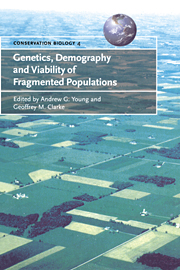Book contents
- Frontmatter
- Contents
- List of contributors
- Foreword by Peter F. Brussard
- Preface
- 1 Introduction: genetics, demography and the conservation of fragmented populations
- Part I Introductory concepts
- 2 Managing and monitoring genetic erosion
- 3 Inbreeding and outbreeding depression in fragmented populations
- 4 Demography and extinction in small populations
- 5 The metapopulation paradigm: a fragmented view of conservation biology
- 6 Population viability analysis for conservation: the good, the bad and the undescribed
- 7 Applications of population genetics and molecular techniques to conservation biology
- Part II Animal case studies
- Part III Plant case studies
- References
- Index
3 - Inbreeding and outbreeding depression in fragmented populations
Published online by Cambridge University Press: 29 January 2010
- Frontmatter
- Contents
- List of contributors
- Foreword by Peter F. Brussard
- Preface
- 1 Introduction: genetics, demography and the conservation of fragmented populations
- Part I Introductory concepts
- 2 Managing and monitoring genetic erosion
- 3 Inbreeding and outbreeding depression in fragmented populations
- 4 Demography and extinction in small populations
- 5 The metapopulation paradigm: a fragmented view of conservation biology
- 6 Population viability analysis for conservation: the good, the bad and the undescribed
- 7 Applications of population genetics and molecular techniques to conservation biology
- Part II Animal case studies
- Part III Plant case studies
- References
- Index
Summary
ABSTRACT
The goal of this chapter is to review inbreeding and outbreeding depression in the context of habitat fragmentation and to show how smaller, fewer populations of any organism separated by distance may exasperate the effects of these two genetic phenomena. We review the genetic basis of each, provide examples, and discuss specific empirical issues that need to be addressed in future research. We conclude with an illustrative case study of how both genetic phenomena can act simultaneously in a single species.
INTRODUCTION
Most rare and endangered species exist as small, isolated populations (Holsinger & Gottlieb, 1989). Unfortunately this seems to be the fate of even common species as natural populations are becoming increasingly fragmented. Fragmentation reduces the number of breeding individuals within a population while reducing gene flow between populations. Consequently, mating between individuals in fragmented populations is more likely to represent selfing (if genetically feasible) and/or biparental inbreeding (matings between related individuals) resulting in inbred offspring. The deleterious consequences of inbreeding are manifold. Inbred progeny may suffer from inbreeding depression, i.e. a decline in fitness, where the relative performance of the resulting inbred progeny is lower compared to progeny produced from matings between unrelated individuals within a population (Falconer & Mackay, 1996). Continued inbreeding associated with small populations also results in the loss of within-population genetic diversity (e.g. Schoen & Brown, 1991). Genetic diversity may influence the colonising ability and persistence of a population (Barrett & Kohn, 1991; Lande, 1994). Decreased genetic diversity may also be associated with increased susceptibility to pathogens and pests (Frankham, 19951b).
- Type
- Chapter
- Information
- Publisher: Cambridge University PressPrint publication year: 2000
- 83
- Cited by

